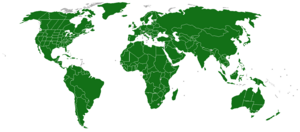Panaeolus papilionaceus facts for kids
Quick facts for kids Panaeolus papilionaceus |
|
|---|---|
 |
|
| Scientific classification | |
| Kingdom: | |
| Phylum: | |
| Class: | |
| Order: |
Agaricales
|
| Family: |
Bolbitiaceae
|
| Genus: |
Panaeolus
|
| Species: |
P. papilionaceus
|
| Binomial name | |
| Panaeolus papilionaceus (Bull. ex Fries) Quélet
|
|
 |
|
| Approximate range of Panaeolus papilionaceus var. papilionaceus | |
| Synonyms | |
|
Agaricus calosus |
|
| Panaeolus papilionaceus | |
|---|---|
| Mycological characteristics | |
| gills on hymenium | |
| cap is convex | |
| hymenium is adnexed | |
| stipe is bare | |
| spore print is black | |
| ecology is saprotrophic | |
| edibility: inedible | |
Panaeolus papilionaceus, also known as the Petticoat Mottlegill, is a very common small brown mushroom. You can find it in many places around the world. This mushroom gets its food from animal droppings, like cow or horse dung. It is the main example for its group of mushrooms, called Panaeolus.
Contents
What Does It Look Like?
The Petticoat Mottlegill has several unique features. Here's how you can identify it:
Cap
- The cap is usually 1 to 5 centimeters (about 0.4 to 2 inches) wide.
- It starts out shaped like a cone, then becomes more like a bell as it gets older.
- The color is grayish-brown.
- When the mushroom is young, or near its edges, you might see small, white, tooth-like pieces. These are leftover bits from a protective covering called a partial veil.
- The cap's flesh is quite thin.
Gills
- The gills are the thin layers under the cap.
- They are attached to the stem, either directly (adnate) or slightly (adnexed).
- The gills are very close together.
- They start out pale gray.
- As the mushroom ages, the gills get a mottled, blackish look.
- The edges of the gills stay whitish.
Spores
- Spores are like the seeds of a mushroom.
- These spores are oval-shaped and smooth.
- They measure about 12 to 18 micrometers long and 7 to 10 micrometers wide.
- Each spore has a small opening at its tip.
- When the spores are released, they create a black spore print.
Stipe (Stem)
- The stem is usually 6 to 12 centimeters (about 2.4 to 4.7 inches) tall.
- It is about 2 to 4 millimeters thick.
- The color ranges from gray-brown to reddish-brown.
- It gets darker if you touch it.
- The top part of the stem is usually paler.
- The stem is brittle and has a fibrous texture.
- It often looks like it has a fine, powdery coating.
Smell and Taste
- This mushroom has a mild smell.
- Its taste is not very pleasant.
Tiny Details (Microscopic Features)
- Under a microscope, you can see that the cells that produce spores (basidia) have four tiny stalks.
- These cells are shaped like a club.
- There are also many special cells called cheilocystidia on the gill edges.
- These are usually cylinder-shaped and sometimes have a small head.
Where It Grows and How It Forms
The Petticoat Mottlegill can be found growing alone, in groups, or in clusters. It commonly grows on the droppings of cows, horses, and moose. You can also find it in pastures where these animals graze.
Global Distribution
This mushroom is found in many places around the world. In North America, it grows throughout the year. In colder areas, you might only see it during warmer months.
It has been found in:
- North America: Canada (like Alberta and British Columbia), and many parts of the United States (including California, Florida, New York, and Texas).
- Caribbean: Islands like the Bahamas and Cuba.
- South America: Countries such as Chile, Colombia, and Uruguay.
- Europe: For example, France, The Netherlands, Greece, and Norway.
- Africa: Including South Africa and Uganda.
- Asia: Such as China, Iran, and the Philippines.
Is It Safe to Eat?
No, Panaeolus papilionaceus is inedible. It doesn't taste good and isn't very big, so it's not worth eating. Some mushrooms that look similar might contain special chemicals like psilocybin, but the Petticoat Mottlegill does not have these. It is best to avoid eating any wild mushrooms unless an expert has identified them as safe.
Gallery
See also
 In Spanish: Panaeolus papilionaceus para niños
In Spanish: Panaeolus papilionaceus para niños
- List of Panaeolus species






